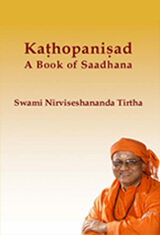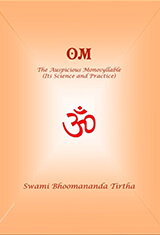Resources
description

Verses for Introspection
Shloka 53 janmaanekashataih
Ma Gurupriya
Shloka 53 janmaanekashataih
Ma Gurupriya
God in the Form of Guru
जन्मानेकशतैः सदादरयुजा भक्त्या समाराधितो
भक्तैर्वैदिकलक्षणेन विधिना सन्तुष्ट ईशः स्वयम् ।
साक्षाच्छ्रीगुरुरूपमेत्य कृपया दृग्गोचरः सन् प्रभुः
तत्त्वं साधु विबोध्य तारयति तान् संसारदुःखार्णवात् ।।
– सर्ववेदान्तसिद्धान्तसारसंग्रहः २५४
janmāneka-śatai: sadādara-yujā bhaktyā samārādhito
bhaktair-vaidika-lakṣaṇēna vidhinā santuṣṭa īśa: svayam |
sākṣācchrīguru-rūpam-etya kṛpayā dṛg-gocara: san prabhu:
tattvam sādhu vibodhya tārayati tān saṃsāra-du:khārṇavāt ||
– sarvavedāntasiddhāntasārasaṅgraha: 254
Translation:
When the Lord is pleased with the devotional worship done in many (hundreds of) lives, with great respect according to Vedic prescriptions, He mercifully appears before the devotees in the form of Sri Guru, and instructing them well revealing the supreme Truth, takes them across the miserable worldly ocean.
Points for Introspection:
The Vedas prescribe the right ways of worshipping God. These prescriptions have the sole aim to strengthen and deepen our devotion, develop fondness for God, and have total reliance on Him.
When a devotee worships God with deep devotion, attentively following the prescriptions of the Vedas, for many years (hundreds of lives), he grows one-pointed devotion to God. Seeing that the devotee has developed exclusive devotion with wholesome surrender to Him, God becomes pleased with him. To lead the devotee to the supreme Goal of spiritual felicity, God appears before him as the Guru.
Why does God who was invisible so far, now take a human form? Till now, the devotee has been worshipping God in idols and images. He has been praying to God in all fondness and devotion, shedding tears in front of the idol while in affliction. He has been chanting God’s name incessantly. But the invisible God was not able to talk to the devotee, utter a few words of solace, and guide him on how to transcend the worldly afflictions and progress on the spiritual path. He was not able to impart spiritual Knowledge to the dear devotee.
A devotee who has been worshipping for years, and whose devotion to God has gradually become exclusive and one-pointed, starts thinking: “Who is this God whom I have been worshipping? Have I come closer to Him through all these years of worship? What is His relationship with me? Will He ever give a reply to my queries? Will He ever bestow upon me the spiritual Knowledge so that I can know Him and attain the state of ever-blissfulness?”
To respond to the sincere yearning of the devotee, to impart supreme Knowledge to him, God has to take the human form, the form of a Sad-guru, who is none other than God Himself. Revealing Himself in front of the devotee in the form of Guru, God guides His dear devotee (disciple) on the spiritual path to reach the ultimate auspicious Goal.
In this śloka, Sri Śaṅkarāchārya very clearly states that Guru is none but God manifest. When a devotee, after years of worship, reaches a state where he needs further guidance in order to transcend worldly sufferings, it is indispensable that he meets a Guru – God in human form – so that the Guru can impart supreme spiritual knowledge to him.
However much a devotee develops intense and exclusive devotion to God, he must have the blessed and rare fortune of meeting a Knower Guru, and learn sitting at His holy feet. To such a disciple, the Guru teaches all about the spiritual Truth, attaining which the devotee transcends the afflictions of the world and reaches the supreme goal of eternal Bliss.
Chanting this śloka repeatedly, we understand the important role and the Supreme position of a Knower Guru in our lives, for attaining the knowledge of the supreme Reality.
Word Meaning:
जन्मानेकशतैः (janmānekaśatai:) = in many hundreds of lives; सदादरयुजा (sadādarayujā) = with great value and respect; भक्त्या (bhaktyā) = with devotion; समाराधितः (samārādhita:) = having been worshipped well; भक्तैः (bhaktai:) = by devotees; वैदिकलक्षणेन (vaidika-lakṣaṇēna) = as prescribed in the Vedas; विधिना (vidhinā) = by following the prescriptions; सन्तुष्टः (santuṣṭa:) = having been pleased; ईशः (īśa:) स्वयम् (svayam) = Lord Himself; साक्षात् (sākṣāt) = perceptible; श्रीगुरुरूपम् (śrīguru-rūpam) = form of the Guru; एत्य (etya) = having taken; कृपया (kṛpayā) = out of compassion; दृग्गोचरः (dṛg-gocara: ) = visible to the eyes; सन् (san) = becoming; प्रभुः (prabhu:) = the Lord; तत्त्वं (tattvam) = Supreme Truth; साधु (sādhu) = well; विबोध्य (vibodhya) = having instructed; तारयति (tārayati) = takes across; तान् (tān) = them; संसारदुःखार्णवात् (saṃsāra-du:khārṇavāt ) = across the worldly ocean of misery.
अन्वयः
भक्तैः जन्मानेकशतैः वैदिकलक्षणेन विधिना सदादरयुजा भक्त्या समाराधितः सन्तुष्टः ईशः प्रभुः कृपया स्वयम् साक्षात् श्रीगुरुरूपम् एत्य दृग्गोचरः सन् तान् तत्त्वं साधु विबोध्य संसारदुःखार्णवात् तारयति ।
bhaktai: janmānekaśataiḥ vaidikalakṣaṇena vidhinā sadādarayujā bhaktyā samārādhita: santuṣṭa: īśa: kṛpayā svayam sākṣāt śrīgururūpam etya dṛggōcara: san prabhuḥ tān tattvam sādhu vibōdhya saṃsāra-duḥkhārṇavāt tārayati.
Verses for Introspection
Shloka 53 janmaanekashataih
Ma Gurupriya
You Might Be Interested In
Shloka 26 kim vaanena
Shloka 26 kim vaanena
Ma Gurupriya
Shloka 39 shantaa mahaa...
Shloka 39 shantaa mahaanto
Ma Gurupriya
Shloka 67 naishaam mati...
Shloka 67 naishaam matis-taavad-urukramaanghrim
Ma Gurupriya










